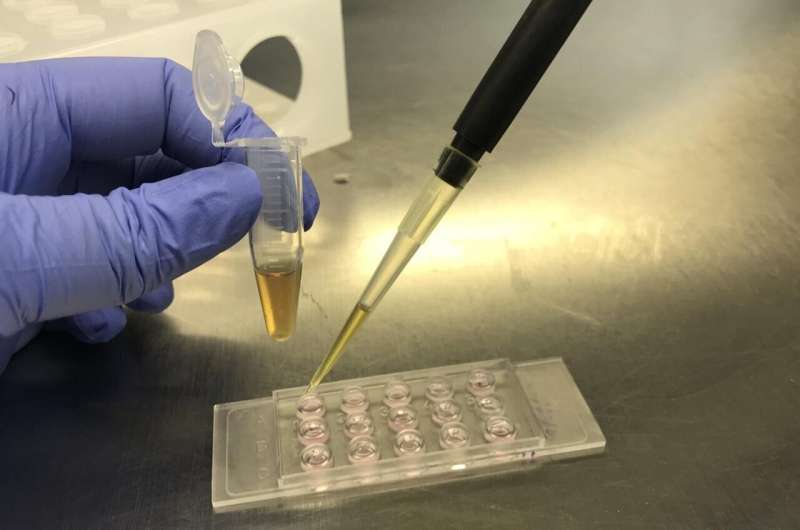This article has been reviewed according to Science X's editorial process and policies. Editors have highlighted the following attributes while ensuring the content's credibility:
fact-checked
peer-reviewed publication
trusted source
proofread
Method for producing sulfur compounds in cells shows promise for tissue repair

Sulfur-based compounds produced in our bodies help fight inflammation and create new blood vessels, among other responsibilities, but the compounds are delicate and break down easily, making them difficult to study.
A team led by Penn State scientists have developed a new method to generate the compounds—called polysulfides—inside of cells, and the work could potentially lead to advances in wound treatment and tissue repair.
The researchers reported their work in the journal Advanced Healthcare Materials.
"Researchers have previously struggled to deliver sulfur species appropriate for biological systems, and we have developed a novel approach that can do that," said Urara Hasegawa, assistant professor of materials science and engineering at Penn State and a corresponding author of the study. "Our work offers a promising option for the controlled delivery of polysulfides for therapeutic applications."
Hydrogen sulfide (H2S), the gas responsible for the rotten-egg smell in natural gas and sewers, is also produced in our bodies, where it appears to act as a signal mediator—sending messages to cells and helping regulate processes in the cardiovascular, nervous and immune systems.
However, according to the researchers, recent studies have suggested that H2S may not actually be the signal mediator. Instead, it may be polysulfides, which are created when H2S mixes with enzymes and oxygen in cells, the scientists said.
Researchers have been unable to confirm this theory, Hasegawa said, because polysulfide compounds are inherently unstable and readily decompose.
"Current research is quite limited because we, as a community, don't know how sulfide species work," Hasegawa said, explaining that the inability to produce a controlled and sustained release of the compounds in biological systems has hindered the advancement of sulfide biology research. "If we want to be able to do basic research, a delivery system is essential, and that's what we have developed here."
The scientists created a novel method to induce the H2S oxidation reaction inside cells by using polymeric micelles, which are self-assembled nano-sized core-shell structures.
These core-shell structures can be taken up by cells and protect what's inside—in this case, manganese porphyrin, a metal complex that can convert H2S to polysulfides.
"We made this nanostructure that works as kind of a nano-capsule," Hasegawa said. "This nano-capsule can protect the porphyrin complex from cellular environment and allows us to catalyze oxidation of H2S to polysulfides species and to do so inside of a cell."
The scientists tested the approach in human umbilical vein endothelial cells, a common model system using the cells lining the vein of the umbilical cord. They found that treating cells with the combination of a H2S donor molecule and the manganese porphyrin-polymeric micelles induced the formation of endothelial cell tubes—or the capillary-like structures that line blood vessels. Adding the H2S donor molecule alone induced only weak tube formation.
"In the angiogenesis—or the formation of new blood vessels—process, endothelial cells are known to transform from a polygonal to elongated form," Hasegawa said, noting that the scientific literature also indicates angiogenesis can induce endothelial cell proliferation and migration. "Cells need to align and reshape to form the innermost layer of the blood vessel that acts as a barrier to confine blood within the vessel."
The results indicate that the conversion of H2S to polysulfides is required for stimulating endothelial cell tube formation. Delivering polysulfides as a treatment could have implications for treating wounds and repairing tissues, the scientists said.
"We are very interested in tissue engineering or tissue regeneration," Hasegawa said. "Our work shows that if we apply these sulfide species, it looks like we can stimulate angiogenesis."
Hasegawa said the team is continuing its research into understanding the mechanisms for the bioactivity of polysulfides. Future work could also involve exploring therapeutic applications for the micelles.
More information: Kemper Young et al, Manganese Porphyrin‐Containing Polymeric Micelles: A Novel Approach for Intracellular Catalytic Formation of Per/Polysulfide Species from a Hydrogen Sulfide Donor, Advanced Healthcare Materials (2023). DOI: 10.1002/adhm.202302429
Journal information: Advanced Healthcare Materials
Provided by Pennsylvania State University





















